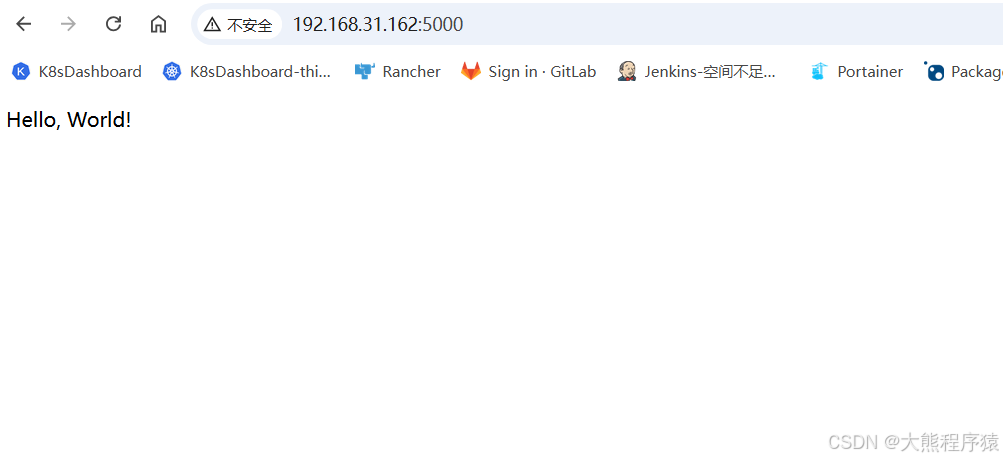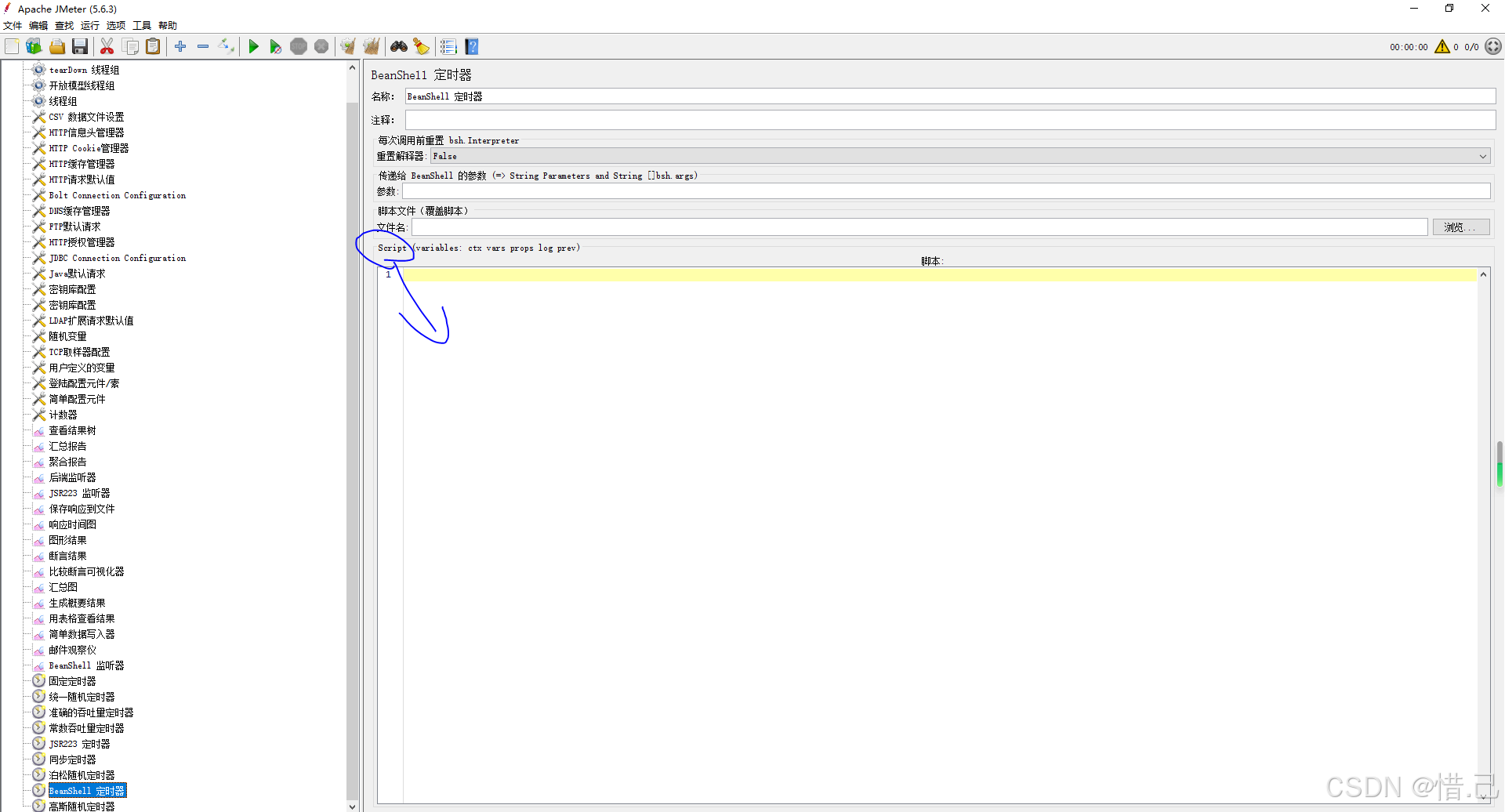摘要
本文详细介绍了Java开发中Spring Test的常见错误和解决方案。文章首先概述了Spring中进行单元测试的多种方法,包括使用JUnit和Spring Boot Test进行集成测试,以及Mockito进行单元测试。接着,文章分析了Spring资源文件扫描不到的问题,并提供了解决方案。最后,文章探讨了Spring的Mock问题,包括Spring Context启动缓慢的原因和优化方法。

1. Spring使用的测试
在 Spring 中,进行单元测试的方式有多种,主要取决于你希望测试的对象以及使用的测试框架。Spring 提供了丰富的测试支持来帮助开发者测试其应用中的各个组件。常见的 Spring 单元测试方法包括以下几种:
1.1. 使用 JUnit 和 Spring Boot Test((多用于集成测试,启动整个 Spring 容器)
1.1.1. @SpringBootTest
@SpringBootTest 是最常用的单元测试注解之一,它会启动 Spring 容器并加载整个 Spring 上下文,适用于集成测试。通常用于测试一个较大的功能,涉及多个组件和服务。
@SpringBootTest
public class MyServiceTest {
@Autowired
private MyService myService;
@Test
void testServiceMethod() {
assertNotNull(myService);
assertEquals("expected result", myService.someMethod());
}
}- 优点: 自动加载整个 Spring 应用上下文,能够进行集成测试。
- 适用场景: 测试需要 Spring 配置、服务和其他组件的复杂业务逻辑。
1.1.2. @WebMvcTest
@WebMvcTest 主要用于测试 Spring MVC 控制器。它只会启动 Web 层相关的组件,不会启动整个 Spring 上下文,因此启动速度较快。
@WebMvcTest(MyController.class)
public class MyControllerTest {
@Autowired
private MockMvc mockMvc;
@Test
public void testController() throws Exception {
mockMvc.perform(get("/api/endpoint"))
.andExpect(status().isOk())
.andExpect(content().string("Expected response"));
}
}- 优点: 只加载 Web 层相关的配置,启动速度快,适合单元测试。
- 适用场景: 测试控制器和 Web 层的请求响应。
1.1.3. @DataJpaTest
@DataJpaTest 用于测试与数据库相关的功能。它只会启动与 JPA 相关的配置,并且自动配置一个嵌入式数据库,适合用于测试数据访问层。
@DataJpaTest
public class MyRepositoryTest {
@Autowired
private MyRepository myRepository;
@Test
void testFindById() {
Optional<MyEntity> entity = myRepository.findById(1L);
assertTrue(entity.isPresent());
}
}- 优点: 快速配置并测试数据库访问,适合单元测试 Repository 层。
- 适用场景: 测试与数据库交互的功能,如 Repository 类。
1.1.4. @MockBean
@SpringBootTest
public class MyServiceTest {
@Autowired
private MyService myService;
@MockBean
private MyRepository myRepository;
@Test
void testServiceMethod() {
when(myRepository.findById(1L)).thenReturn(Optional.of(new MyEntity()));
MyEntity entity = myService.getEntity(1L);
assertNotNull(entity);
}
}- 优点: 可以模拟依赖的 Bean,避免在单元测试时连接到真实的数据库或其他外部服务。
- 适用场景: 测试服务层逻辑时,不依赖实际的数据库或外部服务。
1.2. 使用 Mockito 进行单元测试
Mockito 是常用的 Java 测试框架,可以用来模拟对象(Mock)和验证方法调用。它可以与 Spring 集成,用于服务层或控制器层的单元测试。
1.2.1. @Mock 和 @InjectMocks
@Mock 用于创建一个模拟对象,@InjectMocks 会自动将模拟对象注入到被测试的类中。结合 JUnit 使用时,可以对类中的依赖进行模拟,确保只测试该类的逻辑。
java
复制代码
@RunWith(MockitoJUnitRunner.class)
public class MyServiceTest {
@Mock
private MyRepository myRepository;
@InjectMocks
private MyService myService;
@Test
public void testServiceMethod() {
when(myRepository.findById(1L)).thenReturn(Optional.of(new MyEntity()));
MyEntity entity = myService.getEntity(1L);
assertNotNull(entity);
}
}- 优点: 只测试服务方法,依赖项完全由 Mockito 模拟。
- 适用场景: 单元测试业务逻辑,模拟数据访问层或外部服务。
1.2.2. @MockBean 与 Spring 配合
在 Spring 环境下使用 Mockito,可以通过 @MockBean 注解将模拟对象注入到 Spring 应用上下文中。这样,你可以测试服务层或控制器层,模拟外部依赖。
java
复制代码
@SpringBootTest
public class MyServiceTest {
@MockBean
private MyRepository myRepository;
@Autowired
private MyService myService;
@Test
void testServiceMethod() {
when(myRepository.findById(1L)).thenReturn(Optional.of(new MyEntity()));
MyEntity entity = myService.getEntity(1L);
assertNotNull(entity);
}
}- 优点: 模拟 Spring 管理的 Bean,可以通过 Spring 容器注入,避免直接依赖外部组件。
- 适用场景: 测试 Spring 容器管理的组件,模拟其依赖。
1.2.3. 使用 @TestConfiguration 创建自定义配置
@TestConfiguration 允许你为测试创建一个特殊的配置类,可以在测试中替换部分 Bean 配置。
@TestConfiguration
public class MyTestConfig {
@Bean
public MyService myService() {
return new MyService(new MyRepositoryMock());
}
}- 优点: 在测试中使用自定义配置,替代生产环境中的配置。
- 适用场景: 在单元测试中需要使用特定的测试配置或模拟 Bean 时。
1.2.4. JUnit 5 注解测试@BeforeEach 和 @AfterEach
这些是 JUnit 5 的生命周期注解,用于在每个测试方法之前和之后执行特定的代码。常用于初始化和清理测试环境。
@BeforeEach
void setUp() {
// 初始化代码
}
@AfterEach
void tearDown() {
// 清理代码
}- 优点: 每个测试方法执行之前和之后执行特定的初始化和清理逻辑。
- 适用场景: 初始化和清理测试环境
1.2.5. @TestInstance 控制生命周期
@TestInstance 是 JUnit 5 中的注解,用于控制测试类实例化的生命周期。它可以设置为 PER_CLASS,表示测试类只实例化一次,而不是每个测试方法实例化一次。
java
复制代码
@TestInstance(TestInstance.Lifecycle.PER_CLASS)
public class MyServiceTest {
// 测试方法
}- 优点: 可以避免每个测试方法都实例化测试类,适合需要在类级别共享状态的测试。
- 适用场景: 需要类级别共享状态或资源的场景。
Spring 提供了多种单元测试方法,适用于不同层次的测试需求。常用的方法包括:
@SpringBootTest:用于集成测试,启动整个 Spring 容器。@WebMvcTest:用于测试 Spring MVC 控制器。@DataJpaTest:用于测试 JPA 数据访问层。@MockBean:模拟依赖 Bean,适合服务层测试。- Mockito:用于模拟依赖和验证方法调用,适合单元测试。
根据需要的测试粒度选择合适的测试方法,可以确保高效且全面的测试。
2. SpringBootTest实现单元测试
2.1. SpringBootTest项目与源码示例
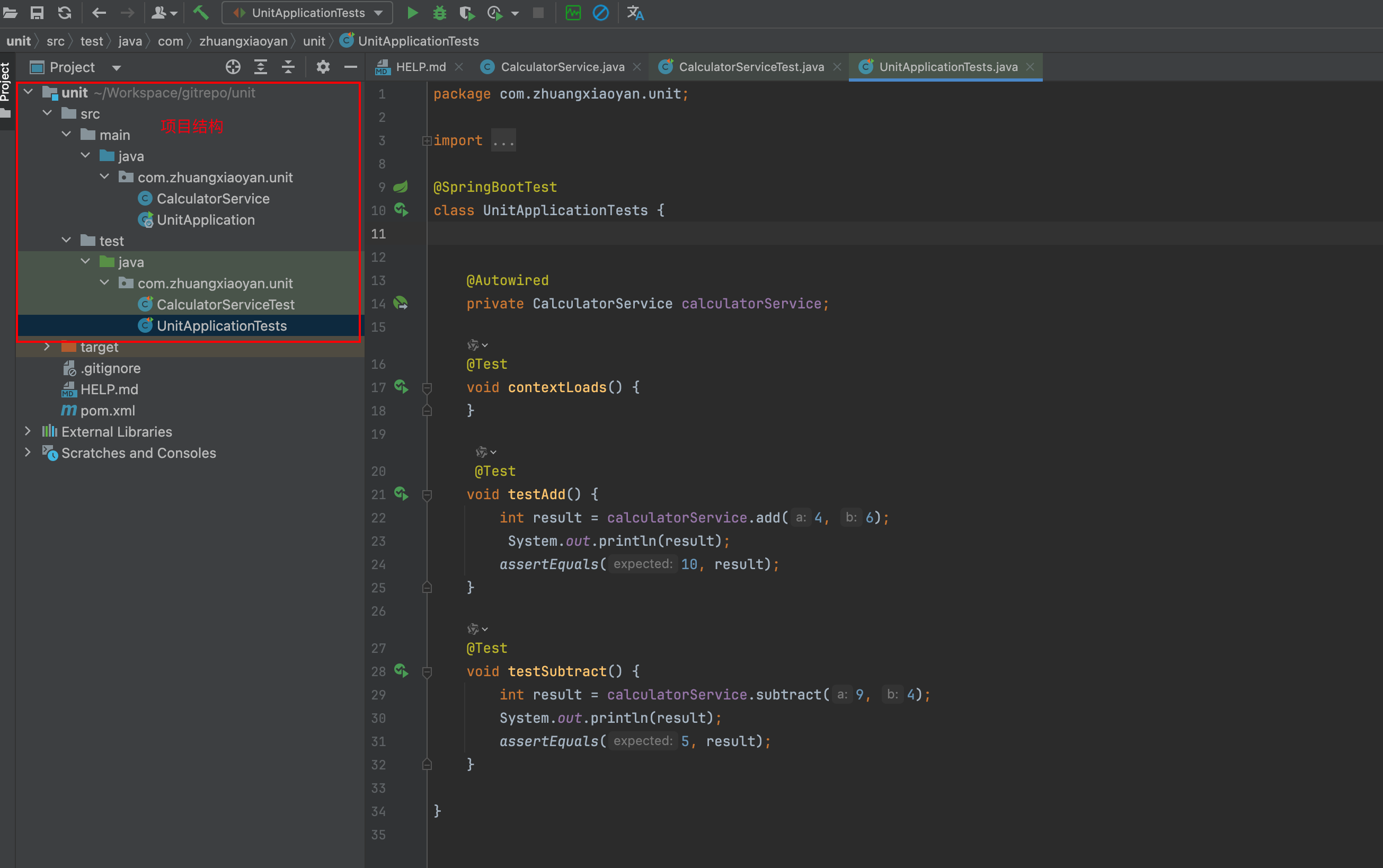
package com.zhuangxiaoyan.unit;
import org.springframework.stereotype.Service;
/**
* CalculatorService
*
* @author xjl
* @version 2024/11/24 10:29
**/
@Service
public class CalculatorService {
public int add(int a, int b) {
return a + b;
}
public int subtract(int a, int b) {
return a - b;
}
}package com.zhuangxiaoyan.unit;
import org.junit.jupiter.api.Test;
import static org.junit.jupiter.api.Assertions.assertEquals;
/**
* CalculatorServiceTest
*
* @author xjl
* @version 2024/11/24 10:29
**/
public class CalculatorServiceTest {
private final CalculatorService calculatorService = new CalculatorService();
@Test
void testAdd() {
int result = calculatorService.add(2, 3);
assertEquals(5, result);
}
@Test
void testSubtract() {
int result = calculatorService.subtract(5, 3);
assertEquals(2, result);
}
}package com.zhuangxiaoyan.unit;
import org.junit.jupiter.api.Test;
import org.springframework.beans.factory.annotation.Autowired;
import org.springframework.boot.test.context.SpringBootTest;
import static org.junit.jupiter.api.Assertions.assertEquals;
@SpringBootTest
class UnitApplicationTests {
@Autowired
private CalculatorService calculatorService;
@Test
void contextLoads() {
}
@Test
void testAdd() {
int result = calculatorService.add(4, 6);
System.out.println(result);
assertEquals(10, result);
}
@Test
void testSubtract() {
int result = calculatorService.subtract(9, 4);
System.out.println(result);
assertEquals(5, result);
}
}
2.2. org.junit.jupiter.api.Test;和JUNIT5 的区别是什么
org.junit.jupiter.api.Test 是 JUnit 5 中的一个注解,而 JUnit 5 是 JUnit 框架的最新版本。
2.2.1. JUnit 4 vs. JUnit 5 的区别
JUnit 4:
- 使用
@Test注解,通常在org.junit包下。 - 没有
@BeforeEach和@AfterEach,而是使用@Before和@After注解。 - 扩展性较差,不像 JUnit 5 那样有完整的扩展机制。
JUnit 5:
- 使用
@Test注解,位于org.junit.jupiter.api.Test包下。 - 引入了新的注解,如
@BeforeEach和@AfterEach(替代@Before和@After)。 - 引入了新的功能,如参数化测试、条件测试、测试生命周期钩子等。
- 提供了更强大的扩展机制,允许用户编写自己的扩展(例如
@ExtendWith)。
2.2.2. JUnit 5 的新特性
- 生命周期钩子:
-
@BeforeEach替代了@Before。@AfterEach替代了@After。@BeforeAll和@AfterAll用于静态方法,替代了 JUnit 4 的@BeforeClass和@AfterClass。
- 扩展性和条件化测试:
-
- JUnit 5 引入了扩展机制,通过
@ExtendWith可以将自定义的扩展类添加到测试类中。 - 可以通过
@EnabledIf和@DisabledIf条件注解来有条件地启用或禁用测试。
- JUnit 5 引入了扩展机制,通过
- 参数化测试:
-
- JUnit 5 提供了更强大的参数化测试支持,如
@ValueSource、@EnumSource、@MethodSource等。
- JUnit 5 提供了更强大的参数化测试支持,如
- 更好的报告和兼容性:
-
- 更好的报告功能,能够输出更详细的测试结果。
- 通过
JUnit Vintage模块,JUnit 5 可以与 JUnit 3 和 JUnit 4 的测试兼容运行。
2.3. Mockito 和 JUnit 版本兼容问题
出现了 Could not initialize plugin: interface org.mockito.plugins.MockMaker 这个错误?Mockito 插件错误通常是由于 Mockito 版本 与 JUnit 版本 不兼容,或者你的项目中的依赖版本不一致。
解决办法:确保你使用的是兼容的 Mockito 和 JUnit 版本。如果你正在使用 JUnit 5,则需要使用兼容的 Mockito 版本。
Maven 依赖示例:如果你使用 JUnit 5 和 Mockito,你应该确保你的 pom.xml 中有以下依赖:
<dependencies>
<!-- JUnit 5 依赖 -->
<dependency>
<groupId>org.junit.jupiter</groupId>
<artifactId>junit-jupiter-api</artifactId>
<version>5.8.2</version> <!-- 根据需要选择版本 -->
<scope>test</scope>
</dependency>
<dependency>
<groupId>org.junit.jupiter</groupId>
<artifactId>junit-jupiter-engine</artifactId>
<version>5.8.2</version> <!-- 根据需要选择版本 -->
<scope>test</scope>
</dependency>
<!-- Mockito 依赖 -->
<dependency>
<groupId>org.mockito</groupId>
<artifactId>mockito-core</artifactId>
<version>4.0.0</version> <!-- 根据需要选择版本 -->
<scope>test</scope>
</dependency>
<dependency>
<groupId>org.mockito</groupId>
<artifactId>mockito-junit-jupiter</artifactId>
<version>4.0.0</version> <!-- 确保使用与 mockito-core 兼容的版本 -->
<scope>test</scope>
</dependency>
</dependencies>
确保使用与 Mockito 4.x 或 JUnit 5 兼容的版本(如上所示)。如果你使用的是 JUnit 4,那么需要使用与之兼容的 Mockito 版本。
3. Spring资源文件扫描不到
@RestController
public class HelloController {
@Autowired
HelloWorldService helloWorldService;
@RequestMapping(path = "hi", method = RequestMethod.GET)
public String hi() throws Exception{
return helloWorldService.toString() ;
};
}当访问 http://localhost:8080/hi 时,上述接口会打印自动注入的HelloWorldService类型的 Bean。而对于这个 Bean 的定义,我们这里使用配置文件的方式进行。
- 定义 HelloWorldService,具体到 HelloWorldService 的实现并非本讲的重点,所以我们可以简单实现如下:
public class HelloWorldService {
}- 定义一个 spring.xml,在这个 XML 中定义 HelloWorldServic 的Bean,并把这个 spring.xml 文件放置在/src/main/resources 中:
<?xml version="1.0" encoding="UTF-8"?>
<beans xmlns="http://www.springframework.org/schema/beans"
xmlns:xsi="http://www.w3.org/2001/XMLSchema-instance"
xsi:schemaLocation="http://www.springframework.org/schema/beans http://www.springframework.org/schema/beans/spring-beans.xsd">
<bean id="helloWorldService" class="com.spring.puzzle.others.test.example1.HelloWorldService">
</bean>
</beans>- 定义一个 Configuration 引入上述定义 XML,具体实现方式如下:
@Configuration
@ImportResource(locations = {"spring.xml"})
public class Config {
}完成上述步骤后,我们就可以使用 main() 启动起来。测试这个接口,一切符合预期。那么接下来,我们来写一个测试:
@SpringBootTest()
class ApplicationTests {
@Autowired
public HelloController helloController;
@Test
public void testController() throws Exception {
String response = helloController.hi();
Assert.notNull(response, "not null");
}
}当我们运行上述测试的时候,会发现测试失败了,报错如下:

3.1. 问题解析
启动程序加载spring.xml
首先看下调用栈:

可以看出,它最终以 ClassPathResource 形式来加载,这个资源的情况如下:

而具体到加载实现,它使用的是 ClassPathResource#getInputStream 来加载spring.xml文件:
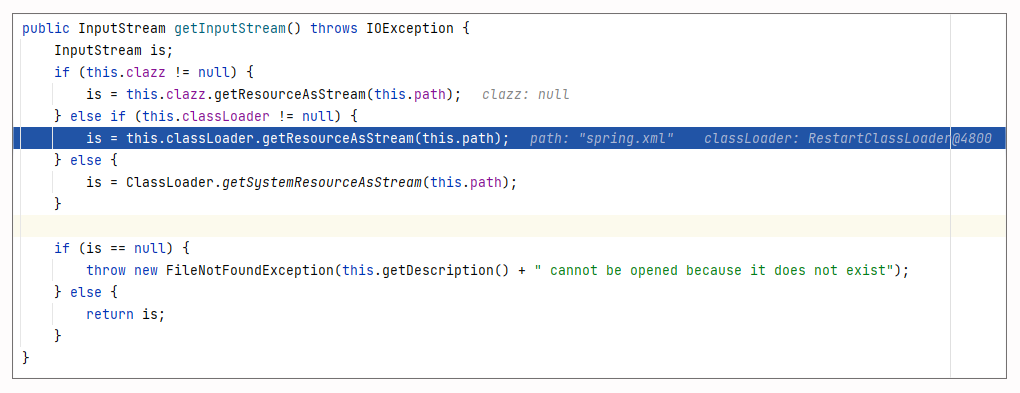
从上述调用及代码实现,可以看出最终是可以加载成功的。
测试加载spring.xml
首先看下调用栈:

可以看出它是按 ServletContextResource 来加载的,这个资源的情况如下:
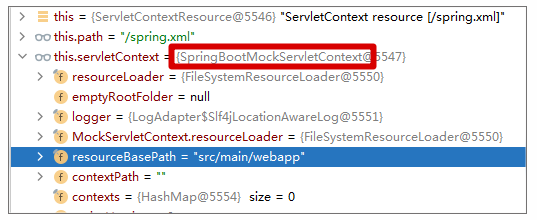
具体到实现,它最终使用的是 MockServletContext#getResourceAsStream 来加载文件:
@Nullable
public InputStream getResourceAsStream(String path) {
String resourceLocation = this.getResourceLocation(path);
Resource resource = null;
try {
resource = this.resourceLoader.getResource(resourceLocation);
return !resource.exists() ? null : resource.getInputStream();
} catch (IOException | InvalidPathException var5) {
if (this.logger.isWarnEnabled()) {
this.logger.warn("Could not open InputStream for resource " + (resource != null ? resource : resourceLocation), var5);
}
return null;
}
}
你可以继续跟踪它的加载位置相关代码,即 getResourceLocation():
protected String getResourceLocation(String path) {
if (!path.startsWith("/")) {
path = "/" + path;
}
//加上前缀:/src/main/resources
String resourceLocation = this.getResourceBasePathLocation(path);
if (this.exists(resourceLocation)) {
return resourceLocation;
} else {
//{"classpath:META-INF/resources", "classpath:resources", "classpath:static", "classpath:public"};
String[] var3 = SPRING_BOOT_RESOURCE_LOCATIONS;
int var4 = var3.length;
for(int var5 = 0; var5 < var4; ++var5) {
String prefix = var3[var5];
resourceLocation = prefix + path;
if (this.exists(resourceLocation)) {
return resourceLocation;
}
}
return super.getResourceLocation(path);
}
}你会发现,它尝试从下面的一些位置进行加载:
classpath:META-INF/resources
classpath:resources
classpath:static
classpath:public
src/main/webapp如果你仔细看这些目录,你还会发现,这些目录都没有spring.xml。或许你认为源文件src/main/resource下面不是有一个 spring.xml 么?那上述位置中的classpath:resources不就能加载了么?
那你肯定是忽略了一点:当程序运行起来后,src/main/resource 下的文件最终是不带什么resource的。关于这点,你可以直接查看编译后的目录(本地编译后是 target\classes 目录),示例如下:

所以,最终我们在所有的目录中都找不到spring.xml,并且会报错提示加载不了文件。报错的地方位于 ServletContextResource#getInputStream 中:
@Override
public InputStream getInputStream() throws IOException {
InputStream is = this.servletContext.getResourceAsStream(this.path);
if (is == null) {
throw new FileNotFoundException("Could not open " + getDescription());
}
return is;
}3.2. 问题修正
从上述案例解析中,我们了解到了报错的原因,那么如何修正这个问题?这里我们可以采用两种方式。
- 在加载目录上放置 spring.xml
就本案例而言,加载目录有很多,所以修正方式也不少,我们可以建立一个 src/main/webapp,然后把 spring.xml 复制一份进去就可以了。也可以在/src/main/resources 下面再建立一个 resources 目录,然后放置进去也可以。
- 在 @ImportResource 使用classpath加载方式
@Configuration
//@ImportResource(locations = {"spring.xml"})
@ImportResource(locations = {"classpath:spring.xml"})
public class Config {
}这里,我们可以通过 Spring 的官方文档简单了解下不同加载方式的区别,参考 Chapter 4. Resources:

很明显,我们一般都不会使用本案例的方式(即locations = {“spring.xml”},无任何“前缀”的方式),毕竟它已经依赖于使用的 ApplicationContext。而 classPath 更为普适些,而一旦你按上述方式修正后,你会发现它加载的资源已经不再是 ServletContextResource,而是和应用程序一样的 ClassPathResource,这样自然可以加载到了。
4. Spring的Mock问题
有时候,我们会发现 Spring Test 运行起来非常缓慢,寻根溯源之后,你会发现主要是因为很多测试都启动了Spring Context,示例如下:
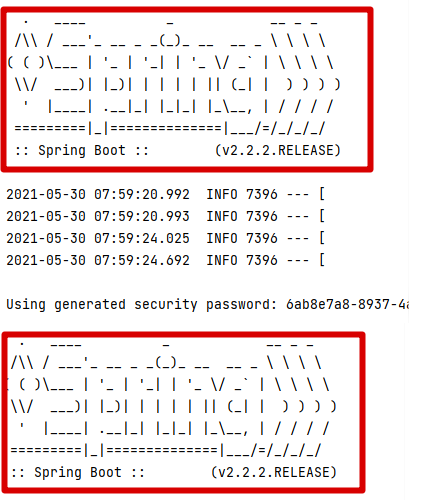
那么为什么有的测试会多次启动 Spring Context?在具体解析这个问题之前,我们先模拟写一个案例来复现这个问题。
我们先在 Spring Boot 程序中写几个被测试类:
@Service
public class ServiceOne {
}
@Service
public class ServiceTwo {
}然后分别写出对应的测试类:
@SpringBootTest()
class ServiceOneTests {
@MockBean
ServiceOne serviceOne;
@Test
public void test(){
System.out.println(serviceOne);
}
}
@SpringBootTest()
class ServiceTwoTests {
@MockBean
ServiceTwo serviceTwo;
@Test
public void test(){
System.out.println(serviceTwo);
}
}在上述测试类中,我们都使用了@MockBean。写完这些程序,批量运行测试,你会发现Spring Context 果然会被运行多次。那么如何理解这个现象,是错误还是符合预期?接下来我们具体来解析下。
4.1. 案例解析
当我们运行一个测试的时候,正常情况是不会重新创建一个 Spring Context 的。这是因为 Spring Test 使用了 Context 的缓存以避免重复创建 Context。那么这个缓存是怎么维护的呢?我们可以通过DefaultCacheAwareContextLoaderDelegate#loadContext来看下 Context 的获取和缓存逻辑:
public ApplicationContext loadContext(MergedContextConfiguration mergedContextConfiguration) {
synchronized(this.contextCache) {
ApplicationContext context = this.contextCache.get(mergedContextConfiguration);
if (context == null) {
try {
context = this.loadContextInternal(mergedContextConfiguration);
//省略非关键代码
this.contextCache.put(mergedContextConfiguration, context);
} catch (Exception var6) {
//省略非关键代码
}
} else if (logger.isDebugEnabled()) {
//省略非关键代码
}
this.contextCache.logStatistics();
return context;
}
}从上述代码可以看出,缓存的 Key 是 MergedContextConfiguration。所以一个测试要不要启动一个新的 Context,就取决于根据这个测试 Class 构建的 MergedContextConfiguration 是否相同。而是否相同取决于它的 hashCode() 实现:
public int hashCode() {
int result = Arrays.hashCode(this.locations);
result = 31 * result + Arrays.hashCode(this.classes);
result = 31 * result + this.contextInitializerClasses.hashCode();
result = 31 * result + Arrays.hashCode(this.activeProfiles);
result = 31 * result + Arrays.hashCode(this.propertySourceLocations);
result = 31 * result + Arrays.hashCode(this.propertySourceProperties);
result = 31 * result + this.contextCustomizers.hashCode();
result = 31 * result + (this.parent != null ? this.parent.hashCode() : 0);
result = 31 * result + nullSafeClassName(this.contextLoader).hashCode();
return result;
}从上述方法,你可以看出只要上述元素中的任何一个不同都会导致一个 Context 会重新创建出来。关于这个缓存机制和 Key 的关键因素你可以参考 Spring 的官方文档,也有所提及,这里我直接给出了链接,你可以对照着去阅读。
点击获取:Redirecting...
现在回到本案例,为什么会创建一个新的 Context 而不是复用?根源在于两个测试的contextCustomizers这个元素的不同。如果你不信的话,你可以调试并对比下。
ServiceOneTests 的 MergedContextConfiguration 示例如下:
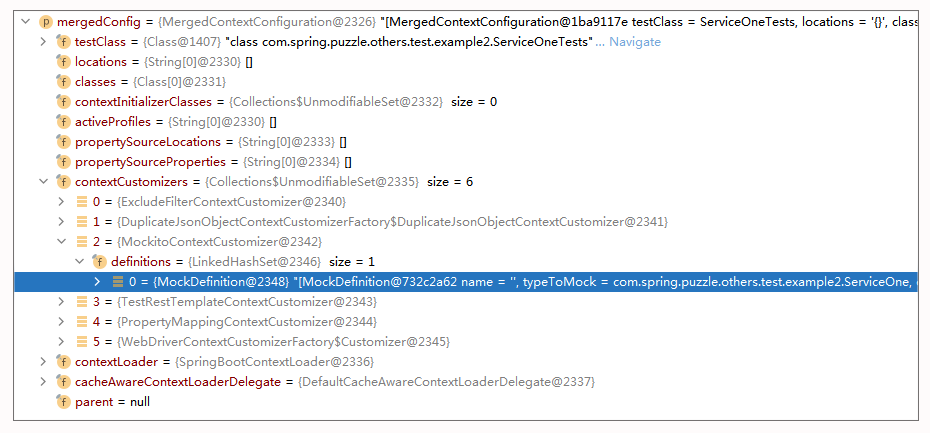
ServiceTwoTests 的 MergedContextConfiguration 示例如下:
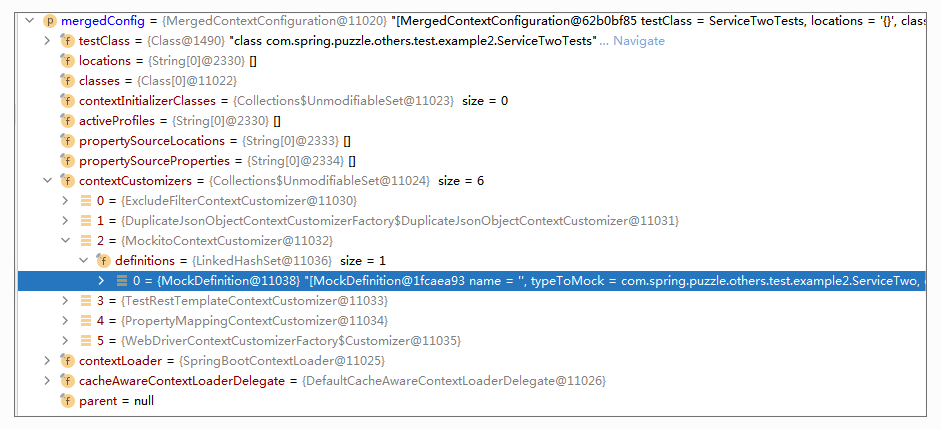
很明显,MergedContextConfiguration(即 Context Cache 的 Key)的 ContextCustomizer 是不同的,所以 Context 没有共享起来。而追溯到 ContextCustomizer 的创建,我们可以具体来看下。
当我们运行一个测试(testClass)时,我们会使用 MockitoContextCustomizerFactory#createContextCustomizer 来创建一个 ContextCustomizer,代码示例如下:
class MockitoContextCustomizerFactory implements ContextCustomizerFactory {
MockitoContextCustomizerFactory() {
}
public ContextCustomizer createContextCustomizer(Class<?> testClass, List<ContextConfigurationAttributes> configAttributes) {
DefinitionsParser parser = new DefinitionsParser();
parser.parse(testClass);
return new MockitoContextCustomizer(parser.getDefinitions());
}
}创建的过程是由 DefinitionsParser 来解析这个测试 Class(例如案例中的 ServiceOneTests),如果这个测试 Class 中包含了 MockBean 或者 SpyBean 标记的情况,则将对应标记的情况转化为 MockDefinition,最终添加到 ContextCustomizer 中。解析的过程参考 DefinitionsParser#parse:
void parse(Class<?> source) {
this.parseElement(source);
ReflectionUtils.doWithFields(source, this::parseElement);
}
private void parseElement(AnnotatedElement element) {
MergedAnnotations annotations = MergedAnnotations.from(element, SearchStrategy.SUPERCLASS);
//MockBean 处理 annotations.stream(MockBean.class).map(MergedAnnotation::synthesize).forEach((annotation) -> {
this.parseMockBeanAnnotation(annotation, element);
});
//SpyBean 处理 annotations.stream(SpyBean.class).map(MergedAnnotation::synthesize).forEach((annotation) -> {
this.parseSpyBeanAnnotation(annotation, element);
});
}
private void parseMockBeanAnnotation(MockBean annotation, AnnotatedElement element) {
Set<ResolvableType> typesToMock = this.getOrDeduceTypes(element, annotation.value());
//省略非关键代码
Iterator var4 = typesToMock.iterator();
while(var4.hasNext()) {
ResolvableType typeToMock = (ResolvableType)var4.next();
MockDefinition definition = new MockDefinition(annotation.name(), typeToMock, annotation.extraInterfaces(), annotation.answer(), annotation.serializable(), annotation.reset(), QualifierDefinition.forElement(element));
//添加到 DefinitionsParser#definitions
this.addDefinition(element, definition, "mock");
}
}那说了这么多,Spring Context 重新创建的根本原因还是在于使用了@MockBean 且不同,从而导致构建的 MergedContextConfiguration 不同,而 MergedContextConfiguration 正是作为 Cache 的 Key,Key 不同,Context 不能被复用,所以被重新创建了。这就是为什么在案例介绍部分,你会看到多次 Spring Context 的启动过程。而正因为“重启”,测试速度变缓慢了。
4.2. 问题修正
到这,你会发现其实这种缓慢的根源是使用了@MockBean 带来的一个正常现象。但是假设你非要去提速下,那么你可以尝试使用 Mockito 去手工实现类似的功能。当然你也可以尝试使用下面的方式来解决,即把相关的 MockBean 都定义到一个地方去。例如针对本案例,修正方案如下:
public class ServiceTests {
@MockBean
ServiceOne serviceOne;
@MockBean
ServiceTwo serviceTwo;
}
@SpringBootTest()
class ServiceOneTests extends ServiceTests{
@Test
public void test(){
System.out.println(serviceOne);
}
}
@SpringBootTest()
class ServiceTwoTests extends ServiceTests{
@Test
public void test(){
System.out.println(serviceTwo);
}
}重新运行测试,你会发现 Context 只会被创建一次,速度也有所提升了。相信,你也明白这么改能工作的原因了,现在每个测试对应的 Context 缓存 Key 已经相同了。
博文参考
《Spring常见错误》






